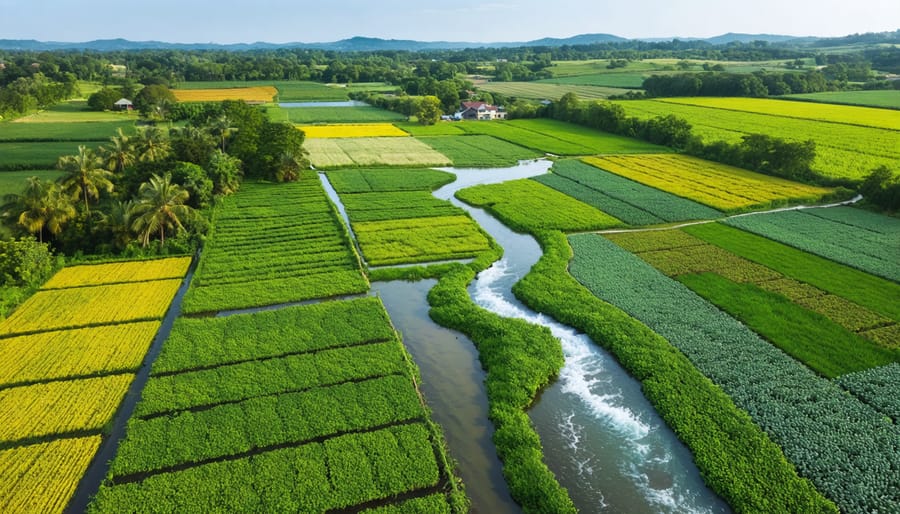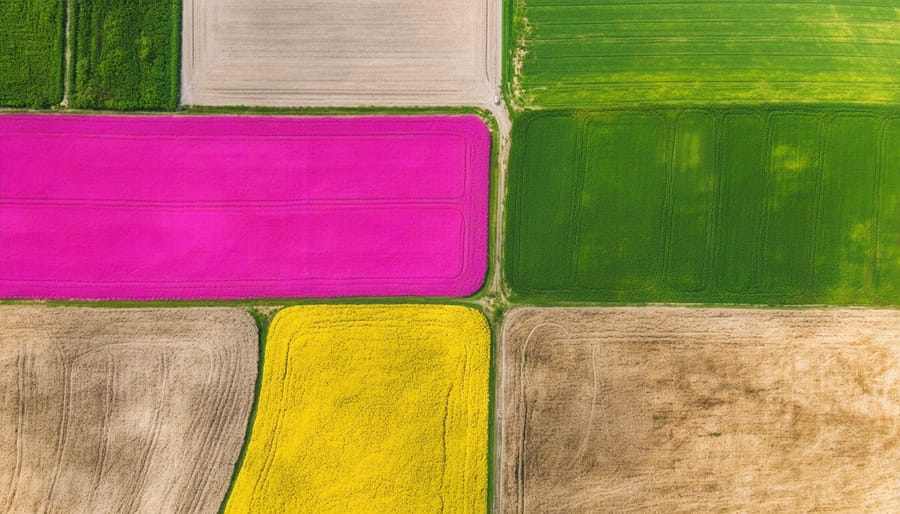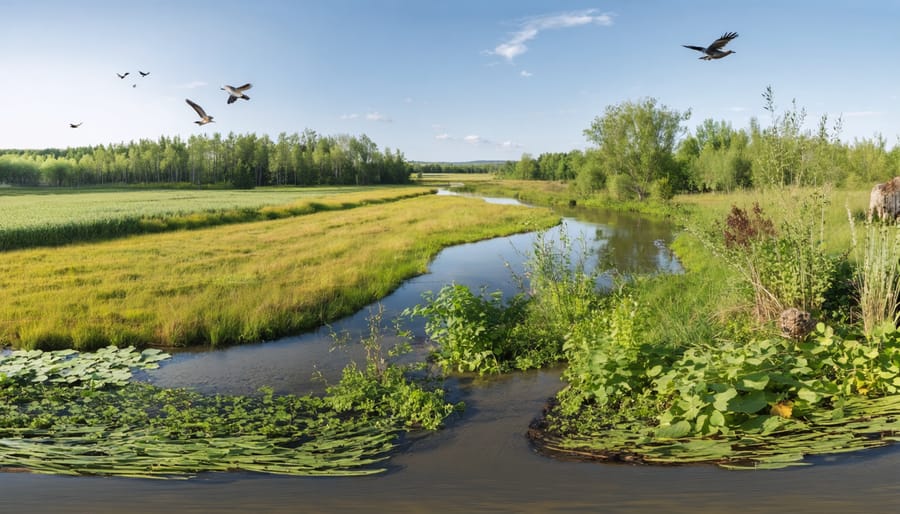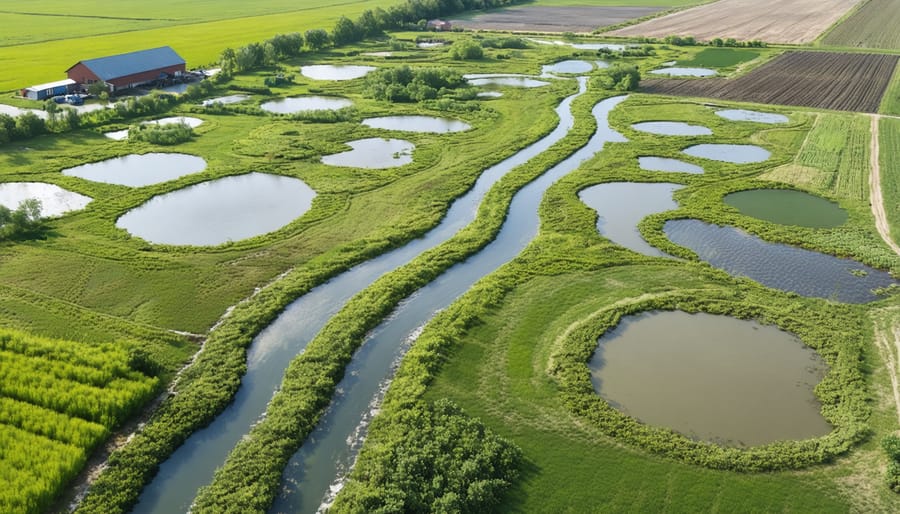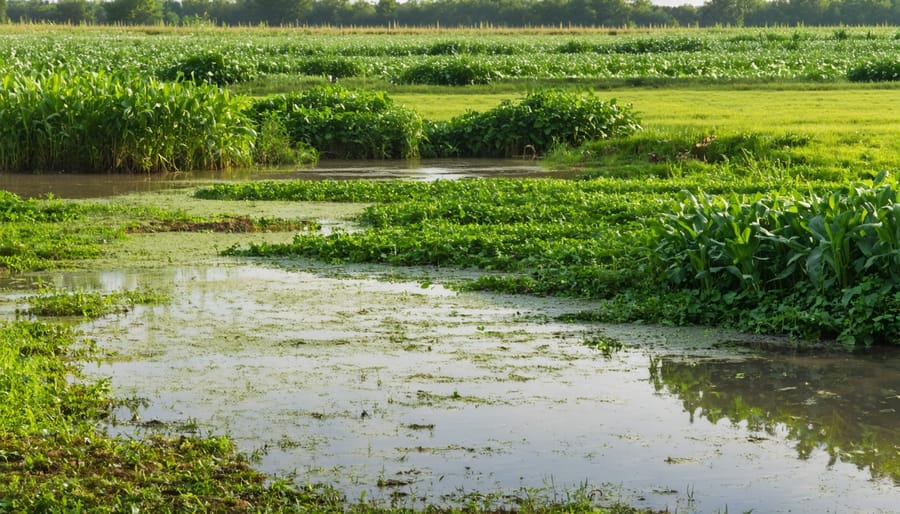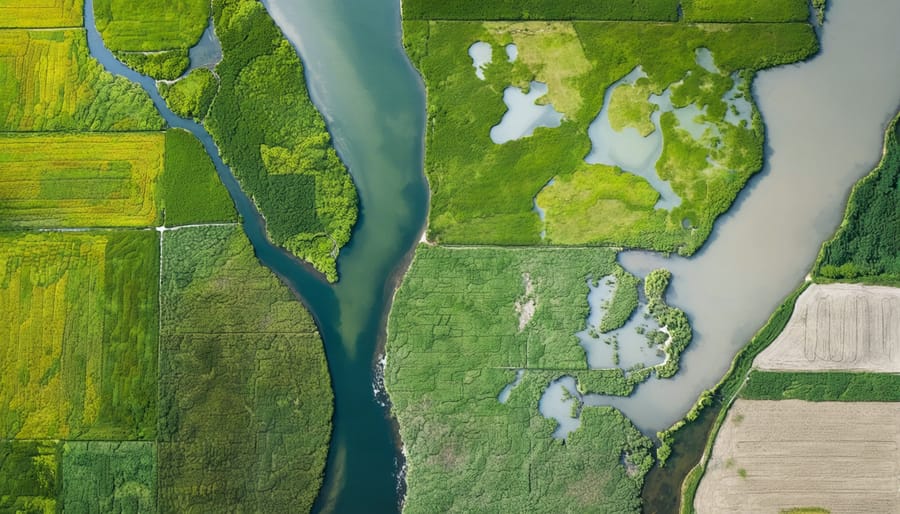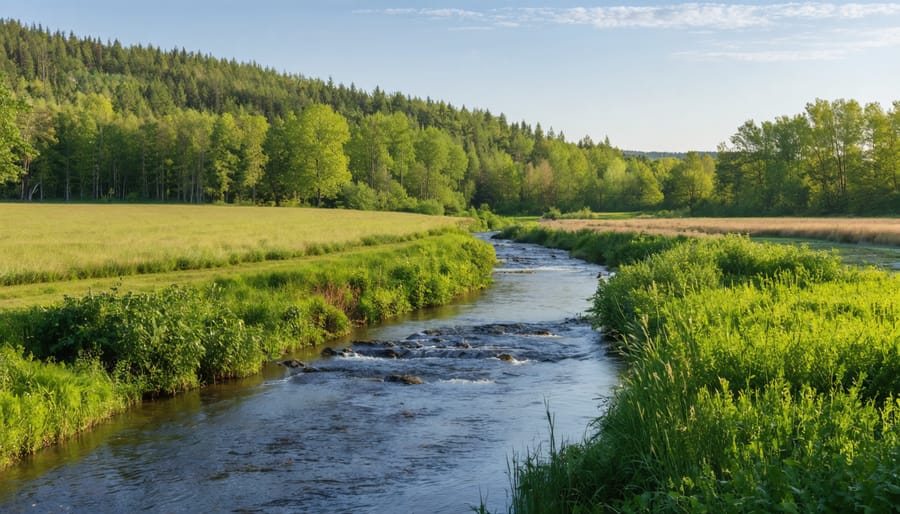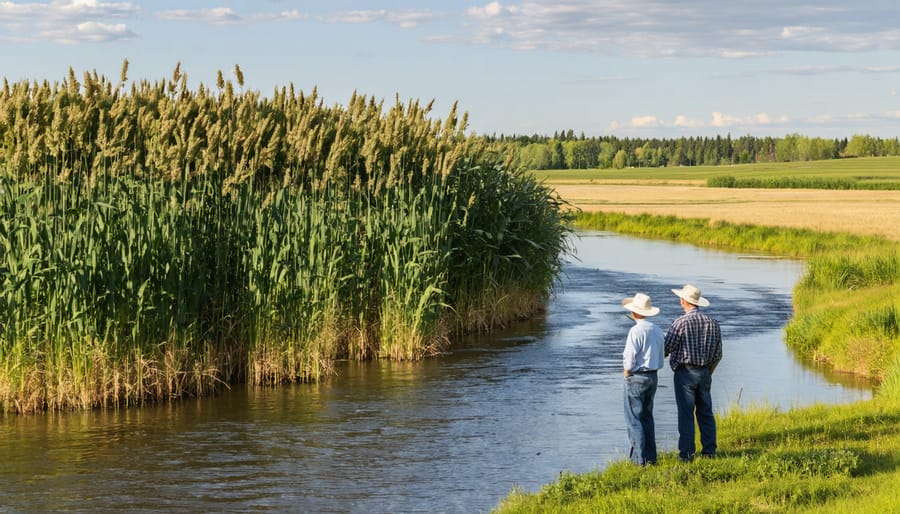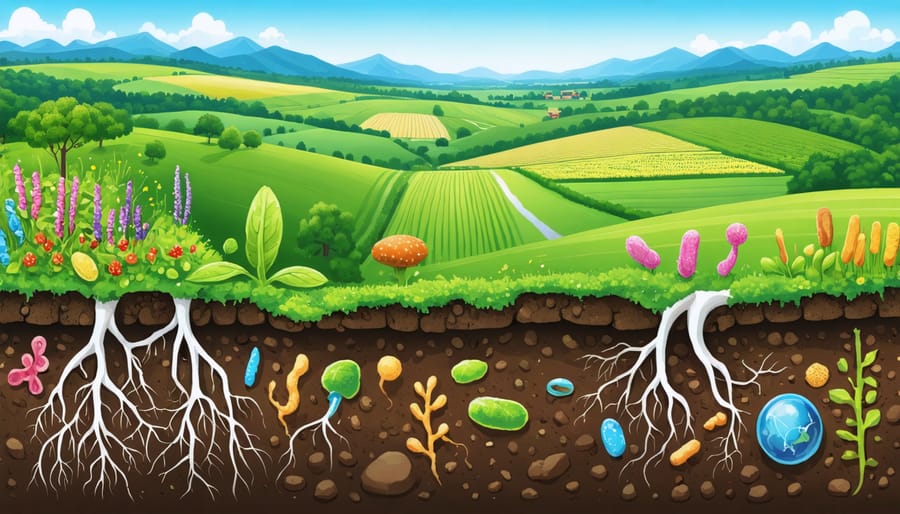Across Alberta’s fertile plains, organic farming practices are revolutionizing the way we think about agricultural productivity and environmental stewardship. Recent studies from the University of Alberta demonstrate that organic farms support up to 30% more species diversity than conventional operations, creating resilient ecosystems that benefit both farmers and the environment. From beneficial insects that naturally control pests to native pollinators that enhance crop yields, the relationship between organic practices and biodiversity represents a powerful solution for sustainable agriculture in Canada’s changing climate.
This practical approach to farming doesn’t just protect wildlife – it strengthens farm operations. Local producers like Sarah Thompson, who manages a 400-hectare organic operation near Red Deer, has documented a 40% increase in bird species and beneficial insect populations since transitioning to organic methods five years ago. Her success story mirrors findings from Agriculture Canada’s long-term research, showing that organic farms typically support 50% more plant species and 35% more beneficial insects than conventional operations.
As we face increasing pressure to produce food sustainably while protecting our natural heritage, organic farming emerges as a proven strategy that delivers on both fronts. This introduction to organic farming’s role in enhancing biodiversity will explore practical methods that Canadian farmers can implement to boost both wildlife populations and farm productivity.
The Natural Synergy of Organic Practices and Wildlife
Chemical-Free Cultivation: A Safe Haven for Species
The elimination of synthetic pesticides and fertilizers in organic farming creates a sanctuary for local wildlife. Studies across Alberta farms show that organic fields support up to 50% more bird species and 30% more beneficial insects compared to conventional operations. These chemical-free environments allow natural predator-prey relationships to flourish, creating a self-regulating ecosystem that naturally manages pest populations.
Local farmer Sarah Thompson from Red Deer County reports seeing a dramatic increase in beneficial insects like ladybugs and ground beetles since transitioning to organic practices five years ago. “We’ve noticed more songbirds nesting in our hedgerows, and our fields are buzzing with pollinators,” she shares.
The absence of synthetic inputs also promotes healthier soil biology, supporting essential microorganisms that form the foundation of the food chain. Research from the University of Alberta demonstrates that organic fields typically host twice the earthworm population of conventional fields, contributing to improved soil structure and nutrient cycling.
This natural approach to pest management not only protects beneficial species but also helps maintain long-term farm sustainability through enhanced ecological balance.
Soil Life: The Underground Success Story
Beneath every thriving organic farm lies a complex network of life that rivals any above-ground ecosystem. In organic soils, earthworms, beneficial bacteria, and fungi work together to create a living, breathing environment that supports healthy crop growth. Studies from the University of Alberta show that organic fields contain up to 50% more earthworms per square metre compared to conventional fields.
These underground workers are nature’s finest soil engineers. Earthworms create channels that improve water infiltration and root growth, while beneficial fungi form vast networks that help plants access nutrients. Bacteria break down organic matter, releasing essential nutrients and building soil structure. This diverse soil community also helps crops naturally resist diseases and pests.
Saskatchewan organic farmer Jim Morton reports that after five years of organic practices, his soil tests showed double the organic matter content and significantly improved water retention. “The soil just feels different now,” he notes. “It’s more like a living sponge than dirt.” This enhanced soil biodiversity not only supports crop health but also provides habitat for beneficial insects and creates more resilient farming systems.

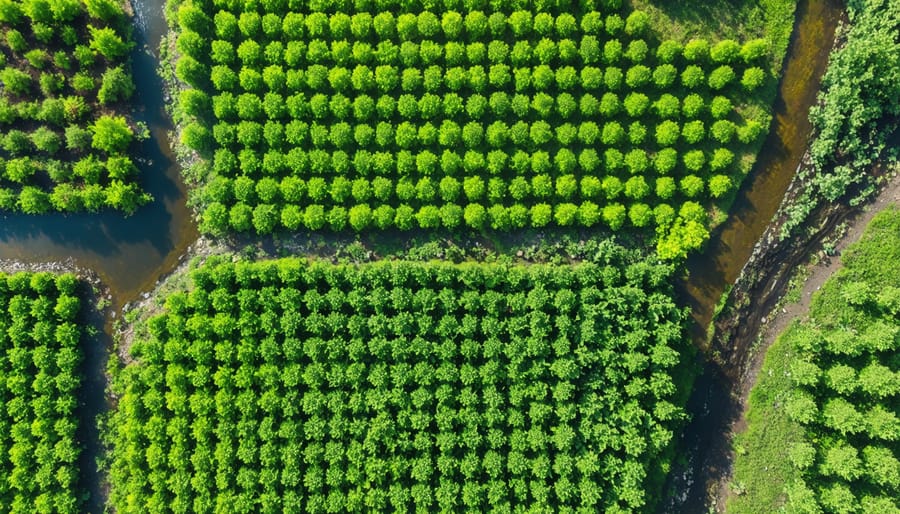
Practical Biodiversity Boosters for Your Farm
Crop Rotation and Companion Planting
Crop rotation and companion planting are cornerstone practices in organic farming that create thriving ecosystems for local wildlife. By rotating crops seasonally, farmers in Alberta have reported significant increases in beneficial insects, including essential pollinators and natural pest controllers.
A successful rotation typically includes alternating between cereals, legumes, and flowering crops over three to four years. This diversity creates year-round habitat opportunities for different species. For example, when canola follows field peas in rotation, the varying plant structures provide nesting sites for ground-dwelling birds and support different insect populations throughout the growing season.
Companion planting takes this approach further by combining complementary crops within the same growing space. Prairie farmers have found success pairing wheat with clover underseed, which not only fixes nitrogen but also provides food sources for beneficial insects and wildlife. Planting indigenous flowering species along field edges creates corridors for wildlife movement while supporting local biodiversity.
Research at the University of Alberta shows that farms implementing these diverse planting strategies host up to 30% more bird species and 50% more beneficial insects compared to conventional monoculture systems. These numbers demonstrate how thoughtful crop planning can transform agricultural lands into biodiversity hotspots while maintaining productive farming operations.
Natural Habitat Creation
Creating wildlife corridors and refuge areas on your farm is one of the most effective ways to support local biodiversity. Here in Alberta, we’ve seen remarkable success with farmers who dedicate just 5-10% of their land to natural habitat creation.
Start by mapping existing natural features like wetlands, tree stands, and native grasslands on your property. These areas serve as anchor points for your wildlife corridors. Connect these features by establishing buffer zones at least 10 metres wide using native plants and grasses common to your region.
Prairie farmers have found success with mixed hedgerows combining saskatoon bushes, chokecherries, and wolfwillow, which provide excellent cover for birds and small mammals. Consider leaving unharvested crop strips (about 3-5 metres wide) along field edges during winter months to provide food and shelter for wildlife.
For wetland areas, maintain a vegetation buffer of at least 30 metres to protect water quality and provide nesting habitat. Dead trees and fallen logs should be left in place when safe to do so, as they offer essential habitat for cavity-nesting birds and beneficial insects.
Local success stories include the Davidson family farm near Red Deer, which increased their bird species count from 12 to 47 after establishing connected habitat corridors over three years. Remember, even small changes like leaving rock piles for snake habitat or installing bee houses can make a significant difference in supporting local wildlife populations.
Water Management for Wildlife
Water features play a vital role in supporting wildlife diversity on organic farms across Alberta. From dugouts and wetlands to simple rain gardens, thoughtfully managed water sources create essential habitat for beneficial insects, birds, and amphibians that contribute to farm health.
When creating water features, consider incorporating different depths and gradual slopes to accommodate various species. Shallow areas of 30-60 cm are perfect for wading birds and pollinators, while deeper zones of 1.5-2 metres provide year-round habitat for fish and aquatic insects. For smaller properties, even a series of connected rain gardens can make a significant difference.
Local farmer Sarah Thompson from Lacombe County shares her success story: “After restoring our farm pond and adding native vegetation around the edges, we’ve seen a dramatic increase in beneficial insects and birds. These visitors help with natural pest control throughout our crops.”
To maintain healthy water features, establish buffer zones of native plants around the edges. These zones filter runoff, prevent erosion, and create additional habitat. Consider plants like cattails, rushes, and sedges, which are well-adapted to Alberta’s climate and provide excellent cover for wildlife.
During winter months, maintain some open water areas if possible, as these become crucial gathering spots for wintertime residents. Simple solutions like solar-powered aerators can help prevent complete freezing while supporting year-round biodiversity.
Alberta Success Stories: Real Results from Local Farms
From Conventional to Thriving Ecosystem
Tom Anderson’s 160-hectare farm near Red Deer, Alberta, tells a compelling story of transformation. “Ten years ago, this was just another conventional grain operation,” Tom recalls, gesturing across his now-thriving organic fields. “Today, it’s a living ecosystem.”
The transition began when Tom noticed declining soil health and fewer wildlife sightings on his land. Inspired by traditional ecological knowledge and modern organic practices, he implemented a holistic approach to farming.
“We started with cover crops and crop rotation,” Tom explains. “Within two years, we saw songbirds returning. By year five, we had documented over 30 species of beneficial insects.” His methods now include maintaining hedgerows, creating wetland buffer zones, and practicing minimal tillage.
The results speak for themselves. Tom’s yield matches regional averages, while his input costs have decreased by 40%. More importantly, his farm now hosts diverse wildlife, including deer, foxes, and numerous bird species. Regular soil tests show significantly improved organic matter content, rising from 2% to 5% over eight years.
“The transformation wasn’t just about switching to organic,” Tom reflects. “It was about seeing the farm as part of a larger ecosystem. Every decision we make considers the entire web of life here.”
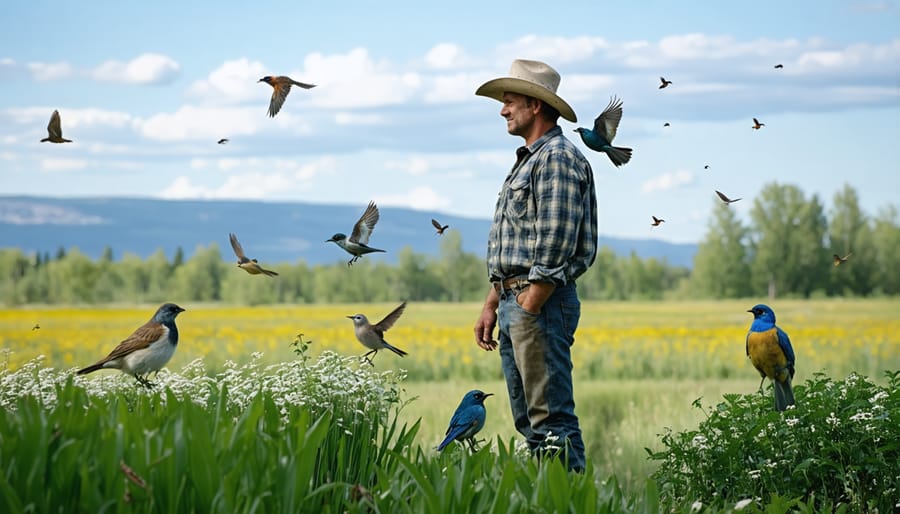
Measuring Biodiversity Success
Alberta farmers are taking impressive strides in tracking biodiversity on their organic farms using both traditional and innovative methods. Many farmers maintain detailed wildlife logs, recording sightings of birds, mammals, and beneficial insects during their daily operations. These observations, when collected consistently over seasons, provide valuable insights into population trends and habitat health.
Popular tracking methods include motion-sensor cameras positioned near wildlife corridors and water sources, helping farmers document nocturnal species and seasonal migration patterns. Some farmers participate in citizen science initiatives, using smartphone apps to photograph and identify species, contributing to broader ecological databases.
Soil biodiversity monitoring is equally important, with farmers conducting regular earthworm counts and implementing the tea bag index method to measure soil decomposition rates. Many Alberta organic producers partner with local naturalist groups for annual bird counts and butterfly surveys, creating a more comprehensive picture of their farm’s ecological health.
Success metrics typically include:
– Number of bird species nesting on the property
– Beneficial insect populations in field margins
– Presence of indicator species like amphibians
– Soil organism diversity and abundance
– Native plant species diversity in uncultivated areas
By maintaining detailed records and sharing data with neighboring farms, organic producers are building a robust understanding of how their practices impact local ecosystems. This collaborative approach helps identify successful biodiversity enhancement strategies while fostering a supportive community of environmentally conscious farmers.
Economic Benefits of Biodiversity
Enhanced biodiversity on organic farms creates multiple revenue streams and cost-saving opportunities that strengthen farm viability. Research from the University of Alberta shows that farmers who enhance farm productivity through biodiversity typically see a 15-25% reduction in pest control costs.
Natural pest control from beneficial insects like ladybugs and parasitic wasps can save farmers an average of $45 per hectare annually on pest management. Native pollinators, when properly supported through habitat preservation, can increase yields in canola and fruit crops by up to 20%. This natural pollination service reduces dependency on rented honeybee colonies, saving approximately $75 per hectare each season.
Soil biodiversity, particularly the presence of diverse microorganisms and earthworms, improves nutrient cycling and soil structure. Prairie farmers report spending 30% less on fertilizers when maintaining healthy soil ecosystems. Enhanced soil biodiversity also increases water retention, reducing irrigation needs by up to 40% during dry periods.
Diverse crop rotations and field margins create opportunities for specialty products like medicinal herbs, native plant seeds, and honey production. Several Alberta farmers have successfully developed side businesses selling these value-added products, increasing their farm income by 10-15%.
Additionally, farms with high biodiversity are more resilient to climate fluctuations and market changes. During the 2021 drought, organic farms with diverse landscapes reported 25% better yield stability compared to conventional monocultures. This economic buffer helps ensure long-term farm sustainability while protecting local ecosystems.
The evidence is clear: organic farming practices play a vital role in protecting and enhancing biodiversity across Alberta’s agricultural landscape. From supporting beneficial insects and pollinators to providing habitat for native birds and mammals, these methods create resilient ecosystems that benefit both wildlife and farm productivity. As we’ve seen through local success stories, farmers who transition to organic practices often report increased soil health, better water retention, and more diverse wildlife populations on their land.
Now is the time for Alberta farmers to consider how organic farming principles can fit into their operations. Whether you’re ready to fully transition to organic or simply want to incorporate select practices, every step toward biodiversity enhancement matters. Start small by implementing buffer zones, reducing chemical inputs, or diversifying crop rotations. Connect with local organic farming associations and fellow producers who can share their experiences and insights.
Together, we can build a future where agricultural productivity and environmental stewardship go hand in hand. The health of our land, the sustainability of our farms, and the preservation of our natural heritage depend on the choices we make today.

